Disclosure: Some posts contain affiliate links, which earn us a commission if you make a purchase through them. Positive Fishing © participates in various affiliate networks including the Amazon Services LLC Associates Program.
The world of carp angling differs from all other freshwater fishing styles. Multiple set-ups, rigs, special techniques, and baits can be used; one of these is the very effective method feeder.
The method feeder rig is perfect for anglers looking to maximize the amount of action on the lakes and rivers, especially for carp but also for species such as bream and tench.
If you fish commercial waters, you’ll find that this fishing style is far and away the most productive, except for pole fishing.
In this article, I will cover the following:
- What is a Method Feeder?
- What Are The Types Of Method Feeders?
- Flat Bottom
- Banjo
- What Is An Inline Method Feeder?
- Method Feeder Weights And Sizes
- What Fish Can I Catch Using A Method Feeder?
- What Fishing Gear Should I Use With A Feeder?
- Rod
- Reel
- Bite Alarms
- Line
- How to Set Up a Method Feeder?
- Attaching The Method Feeder
- Best Hook Length When Using Method Feeder?
- Best Hook Sizes Using Method Feeder?
- Best Mix To Use With A Method Feeder?
- How To Load The Method Feeder With Bait?
- How To Mix And Load The Method Feeder?
- How Long Does The Mix Take To Dissolve?
- Best Hookbaits To Use With A Method Feeder?
- How Often Should I Cast A Method Feeder?
- Final Thoughts
What Is A Method Feeder?
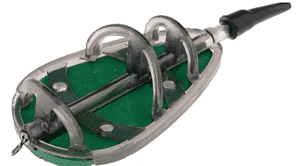
A method feeder is an open feeder for holding pellets or ground bait together in an egg shape. Your baited hook sits on top of the groundbait or the pellet mix. These feeders can be either a free-running inline style or an attached elasticated option.
The most common type of method feeder is the flat bottom feeder. Once in the water, it falls through the water and rests on the bottom face up.
As the feeder sits on the lake or river bed, it eventually begins to fall apart and expose the baited hook. Once the fish grabs the big pile of bait that the hook is sitting upon, you’ll see the classic double-tap on the rod tip, and the hook will be set in the fish’s mouth.
You can enjoy your fishing by sitting and waiting for a bite, knowing that there is quite a bit of work being done below the surface with the groundbait or pellets breaking apart and attracting carp or other target fish right next to your bait.
What Are The Types Of Method Feeders?
Method feeders are beloved within the coarse fish fishing community, and as years have passed, new types are being designed. However, the flat bottom and banjo method feeders are still at the top of the list for the most productive!
Flat Bottom
A flat-bottom method feeder is easy to imagine based on its name. These method feeders are bottom-weighted, so the bait faces up while the feeder sits on the lake bed.
Once you cast it, it’ll right itself and drop to the bottom with your bait facing up the entire time. Unless the bait falls off the hook, you don’t have to worry about it being stuck on the bottom. It’ll always be facing the surface!
Banjo
The other common type of method feeder is a banjo feeder. Due to the attached stem and weight, the feeder looks like the shape of a banjo. The weight is removable, making the banjo feeder a bit more versatile than the flat bottom feeder. Depending on how much weight you need, you can attach different weights to the stem.
What Is An Inline Method Feeder?
An inline method feeder was created for fish conservation purposes. If you hook into a fish and it snaps your line, the method feeder will fall off the line and not be dragged around by the fish!
In many fisheries, fixed-method feeders are banned, and most reputable manufacturers, such as Drennan, Guru, Preston, and Korda, have stopped producing these fixed feeders.
Method Feeder Weights And Sizes
The most common weight feeders come in two sizes: a small base with weights of 24 grams and 36 grams and a large base with weights of 28 grams and 45 grams. This does vary slightly from each method feeder manufacturer.
Choosing which one is best for you is based on the distance you plan to fish and the species you are targetting. The heavier the feeder means you can cast it further, and the small base holds less bait than the larger base.
I carry all the different options in my tackle box. I recommend you have both the small and large versions with you at different weights. They are not very expensive and should last a fairly long time.
What Fish Can I Catch Using A Method Feeder?
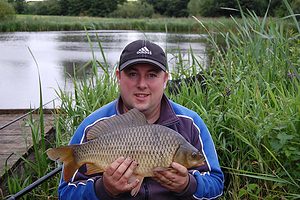
prime method feeder fishing target
It’s hard to find fish that wouldn’t be attracted to a method feeder. The excess of easily eaten food is too tempting for fish to pass up. Method feeder fishing for carp is the most common fish; however, the method feeder can catch all fish that feed off the bottom.
Smaller feeders can also be used to target roach, skimmers, and F1’s or during the winter months when the fish do not need as many free bait offerings.
What Fishing Gear Should I Use With A Feeder?
Rod
There is no special rod that is needed for method feeder fishing. Most anglers carry a ledger rod that can also be used for feeder fishing.
The best type of rod to use when method feeder fishing is a feeder rod. Typically, the rod would be between 9 feet long to 11 feet long. The 9 feet are better for short-distance fishing, and the 10 or 11 feet are better for long-range casting.
These rods are light and have wonderful, sensitive action. They are not meant to be used to target massive fish in extremely tough conditions. You can make up to 100 feet casts and handle small to medium-sized carp up to 15 lbs.
These rods have extremely sensitive tips, making them easy to detect whenever a carp takes up your bait. The tips are often coloured to give you an even better idea of when your bait is being eaten off the bottom.
Many feeder rods you can purchase often come with two or more tips to give an option when fishing with either the smaller or larger method feeders. But in most cases, this is not required.
My favourite feeder rods are the Guru N-Gauge feeder Rod, the Freespirit CTX power feeder rod, and the Daiwa N’zon method feeder range. These are reputable brands and make your time targeting carp that much easier.
As a side note, If you’ve spent any time fly fishing, you may see similarities between a Euro Nymphing rod and a feeder rod.
Reel
You want to ensure your reel pairs well with the rod you have for feeder fishing. You want to fish with a reel that’s between 3500 and 5500. Reels this size can cope with all the range of method feeder weights and sizes.
Baitrunner reels such as the Shimano range are critical to use if you’re fishing with any feeder, especially a method. The fish will “bolt” once it takes your bait, and without the baitrunner clutch and free running, you will likely lose your rod in the water!
If you do not own a baitrunner, then you want the reel to be smooth, especially if you’re letting your bail sit open and allowing the carp to take the bait for a while before you set the hook.
A strong grip, tough drag system, and high winding power are the keys to a great feeder reel. As long as you feel that you have a strong balance, you’ll be good to go.
Bite Alarms
Bite alarms can be used when method feeder fishing; however not essential. The bites from fish are quite aggressive, and it is easy to detect a fish has taken your bait.
I recommend using electronic bite alarms only if you are night fishing away from your rods. Bite alarms serve very little purpose at short distances, such as margin fishing.
Line
The next decision is what size line will work best on your method feeder setup. Typically, the fish targetted would be best with monofilament lines between 4lb and 10lb breaking strain or test.
They aren’t overly heavy lines, but carp have extremely good eyesight, so you don’t want to put yourself in a situation where you spook them away by using a large diameter line.
You’re good to go as long as it’s strong enough to sustain a medium-sized carp.
Always keep the line tight between your reel and the method feeder; this will ensure that when you get a bite, the fish will hook itself almost immediately.
How To Set Up A Method Feeder?
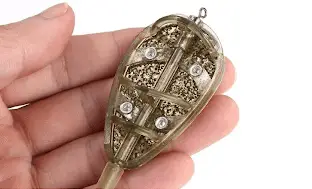
Setting up a method feeder for the first time can be confusing. You’ll find that the challenge comes with wondering where and how to place the method feeder itself. Once you’ve done it the first time, you’ll find it’s super simple after that.
Attaching The Method Feeder
Setting up an inline feeder isn’t overly complicated. The feeder has all the weight you need to be attached to it, so all you need is the feeder and a hook. Your first step is to put the line through the hole in the method feeder and pull it through to the other side.
Slide a bead onto your line to act as an absorber when the method feeder moves around. Also, after you’ve attached the bead, attach it using an improved clinch knot. Once the method bead is on the bottom side of the method feeder, you want to attach a swivel.
Once the swivel is attached, you can tie your short hook length section to the swivel. This small section of leader line should either have a hair rig or a pellet band below the hook, or you can attach the bait directly to your hook. You should try to disguise the hook as best as you can.
Best Hook Length When Using Method Feeder?
When choosing your hook length for a method feeder, the best choice is between four and six inches. You can buy ready-tied 4” hook lengths in all fishing tackle shops.
The short 4” hook length ensures that as soon as the bait is picked up, the bite will result in the fish usually hooking itself. Longer hook lengths can be an issue by getting tangled and not sitting correctly on top of the bait. I strongly recommend the Drennan method bandits – carp feeder or carp method hooks to nylon.
So keep the length short to maximize your catching chances.
Best Hook Sizes Using Method Feeder?
Method feeder fishing targets fish around 1lb to 15lb in weight; therefore, most anglers will use a range of hooks from a size 16 down to a size 10.
Best Mix To Use With A Method Feeder?
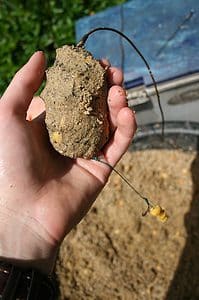
There are a variety of baits you can use on your method feeders. Some popular options include crushed boilies, pellets, and groundbait made from bread.
If you are using pellets or crushed boilies, you must soak them first so that they can be mixed together and then moulded when applied to your feeder. Likewise, bread-based groundbait requires water to be added to get the right consistency. Basically, we are creating a bait ball that sits firmly on the method feeder.
The trick with these is that you don’t want it to be too wet that it will break down and expose your hook. You also don’t want it too dry so that it will break down as soon as it gets wet. This process takes a few tries to master, but every angler must learn to do it correctly.
Also, the bait must stay attached to the method feeder when you cast!
Alternatively, If you struggle with this process, you can buy ready-made method mixes, which are easier to get into the right consistency. Whilst they are more expensive, they have additives and other attractants in them to help draw the fish to your bait.
How To Mix And Load The Method Feeder?
Wet your pellets and let them soak for 1 or 2 minutes in a bucket or container to get the perfect combination. Once they’ve soaked, remove all the water in the container and let the pellets dry for 10-15 minutes.
Start forming the pellets and test their quality by dropping them in the margin. If they start breaking up after a minute or two, you’re good to go.
Once your rig is set up and you have the bait at the proper consistency, you can assemble the feeder. Mash the feeder into an egg-shaped bait ball so everything is neatly attached, and then squeeze the mix onto the top of the method feeder.
Your method feeder should have a plastic mould correctly sized for the specific method feeder. The mould makes it easy to have the right shape and firmness to press the bait onto the feeder, and it stays in place until it rests on the bottom of the lake or river.
Once the bait is properly attached, you can cast it to where you would like your bait to sit.
How Long Does The Mix Take To Dissolve?
A well-made mix will dissolve and break down after one or two minutes as it’s sitting on the river or lake bed. After five minutes, the bait on your hook will become visible to the fish with the groundbait spread around the bait; if there are fish already surrounding it, the mix will break up even faster.
Best Hookbaits To Use With A Method Feeder?
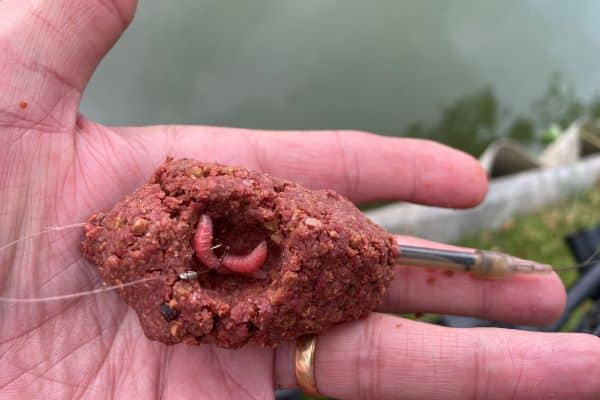
Besides pellets, my favourite hook bait to use when method feeder fishing is sweetcorn. I have had great success catching carp and bream on these bright yellow kernels. The combination of the corn sweetness and the colour sitting on top of the groundbait really seems to attract them to take the bait.
Other alternatives that work well are maggots (both live and dead), worms, and small boilies.
How Often Should I Cast A Method Feeder?
It would be best if you regularly cast your feeder out; this is not like pre-baiting a particular area on the lake bed and waiting for the carp to come in.
Personally, I find that leaving the feeder a maximum of 20 minutes is a good guide, but on some more prolific commercial waters, I will cast as often as every 3 -10 minutes to get more bait in and find the right spots.
Once you have found the fish, always try to cast in the same spot each time, as the fish will likely continue to feed and return to that area.
Final Thoughts
The method feeder can be extremely prolific when targetting carp and bream around the 2lb to 10lb range.
Whether it’s a pleasure fishing or a match fishing scenario, method feeders are one of the best fishing styles you can use. They are a small investment and can be used with the fishing tackle that you currently already own!
I hope you enjoyed this article and are ready to go out and fish this exciting method feeder style.
- 5 Best Fishing Bags For Getting Your Gear Organized - January 13, 2025
- 4 Essential Surf Fishing Rigs - January 11, 2025
- How To Know The Sex Of A Fish You Have Caught? - December 9, 2024

